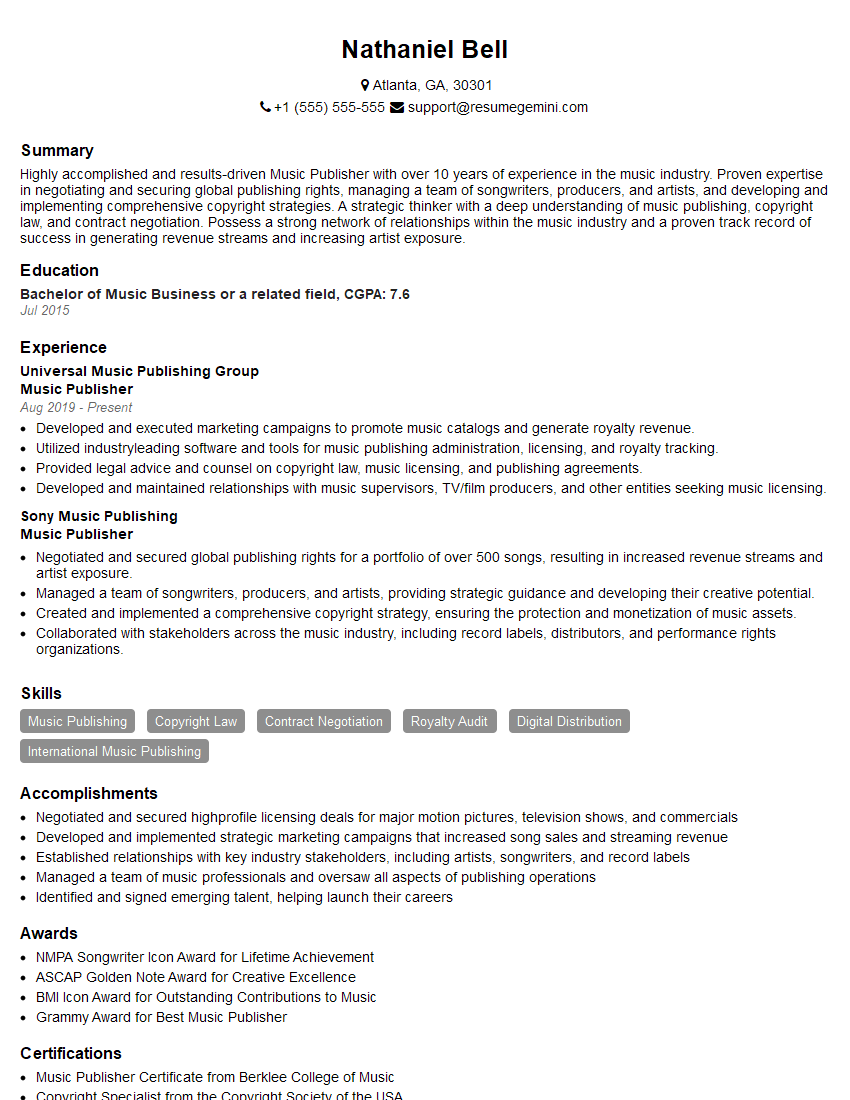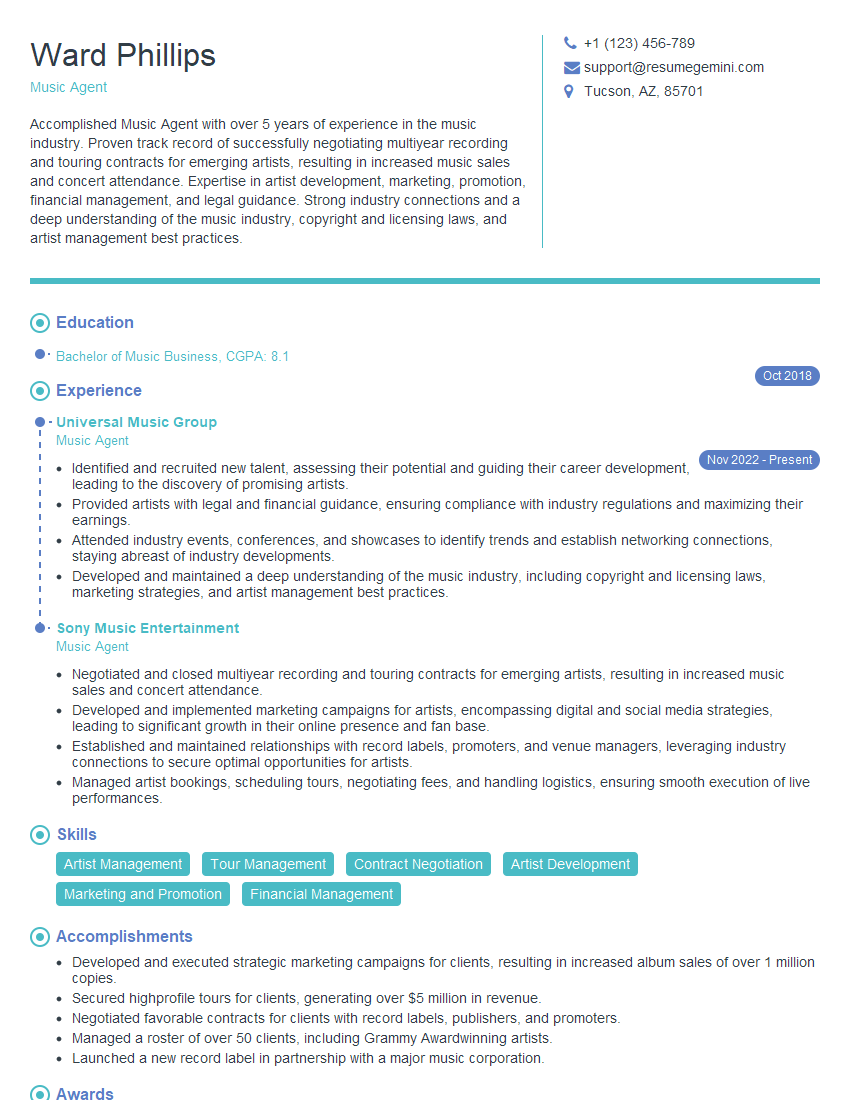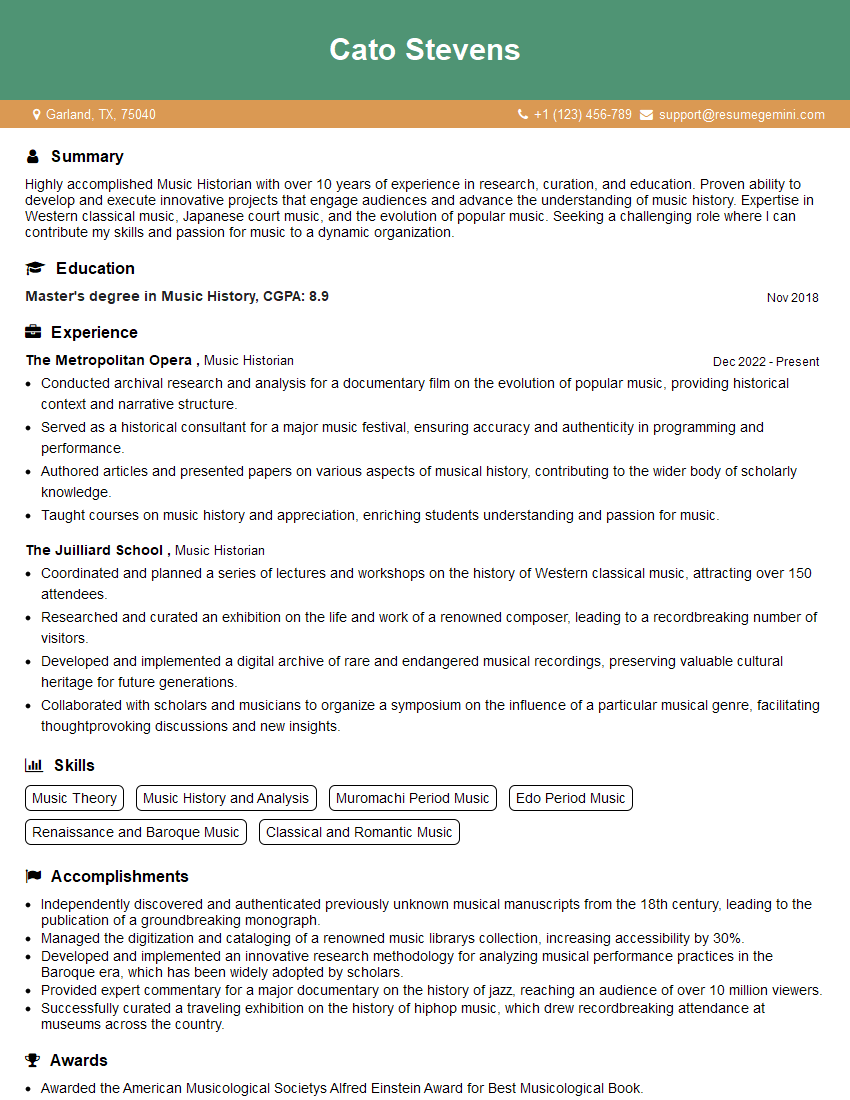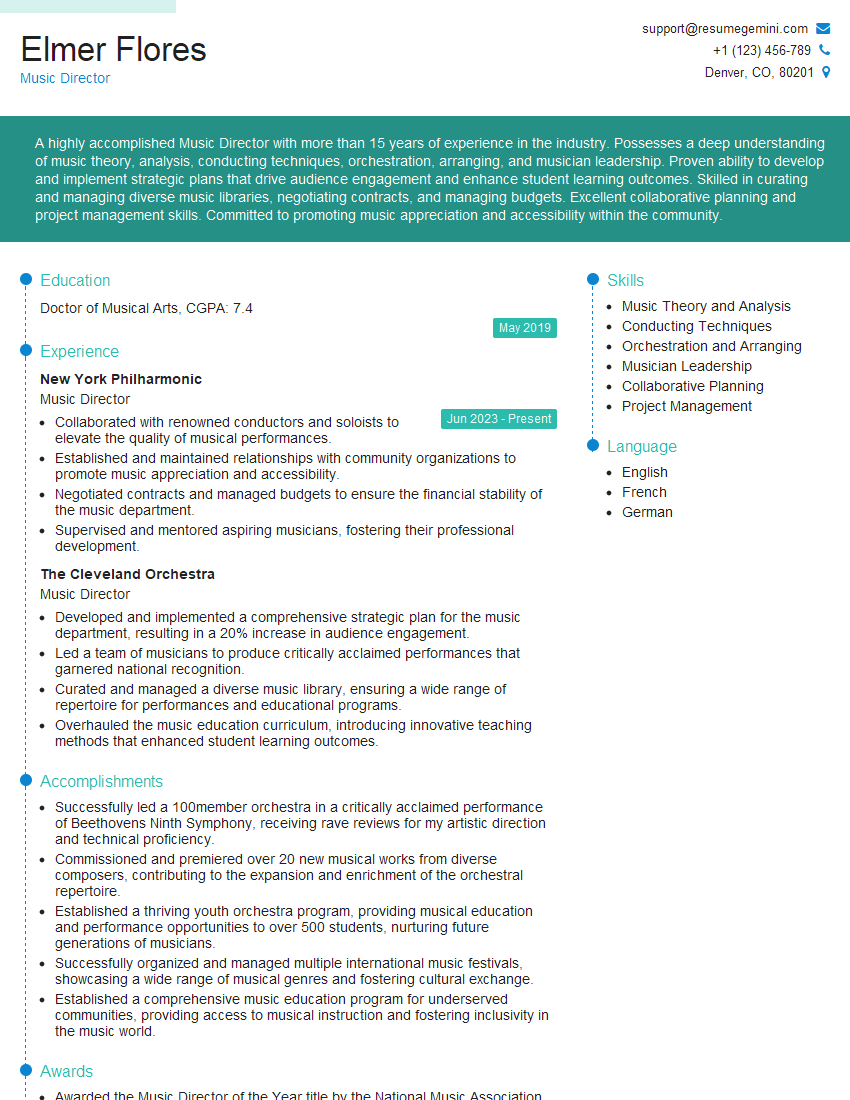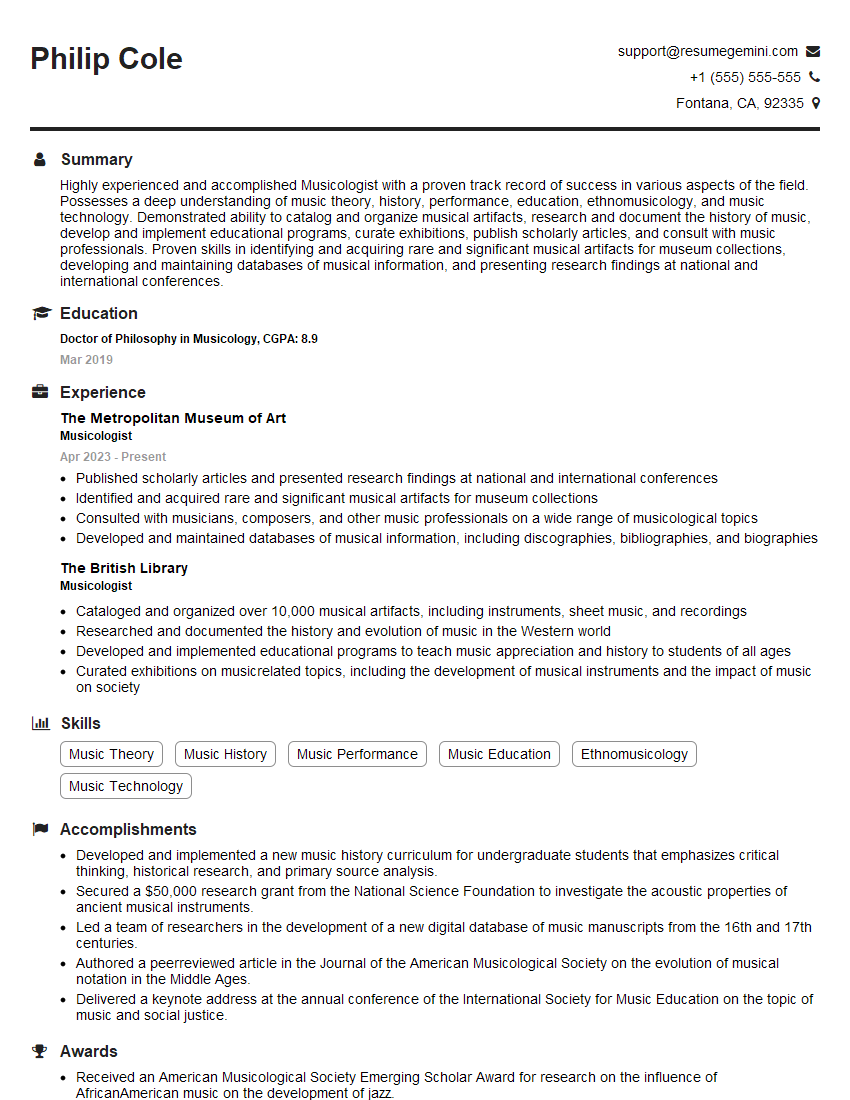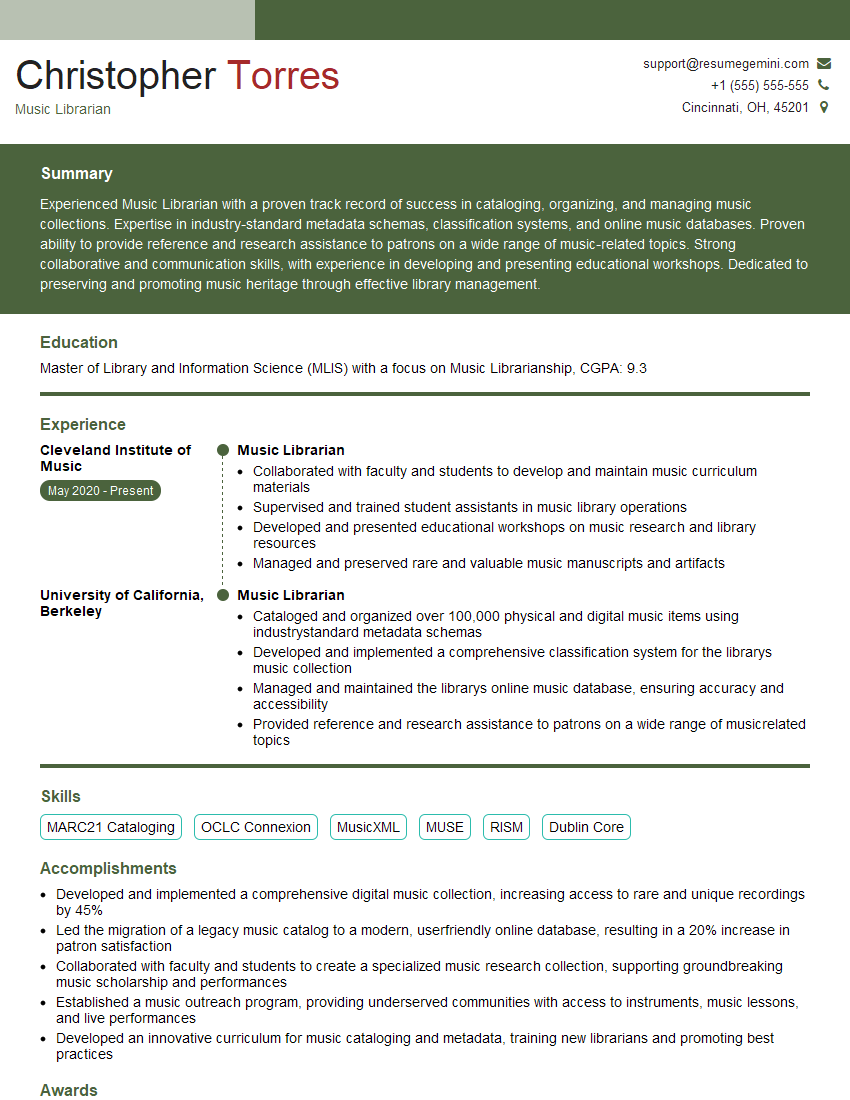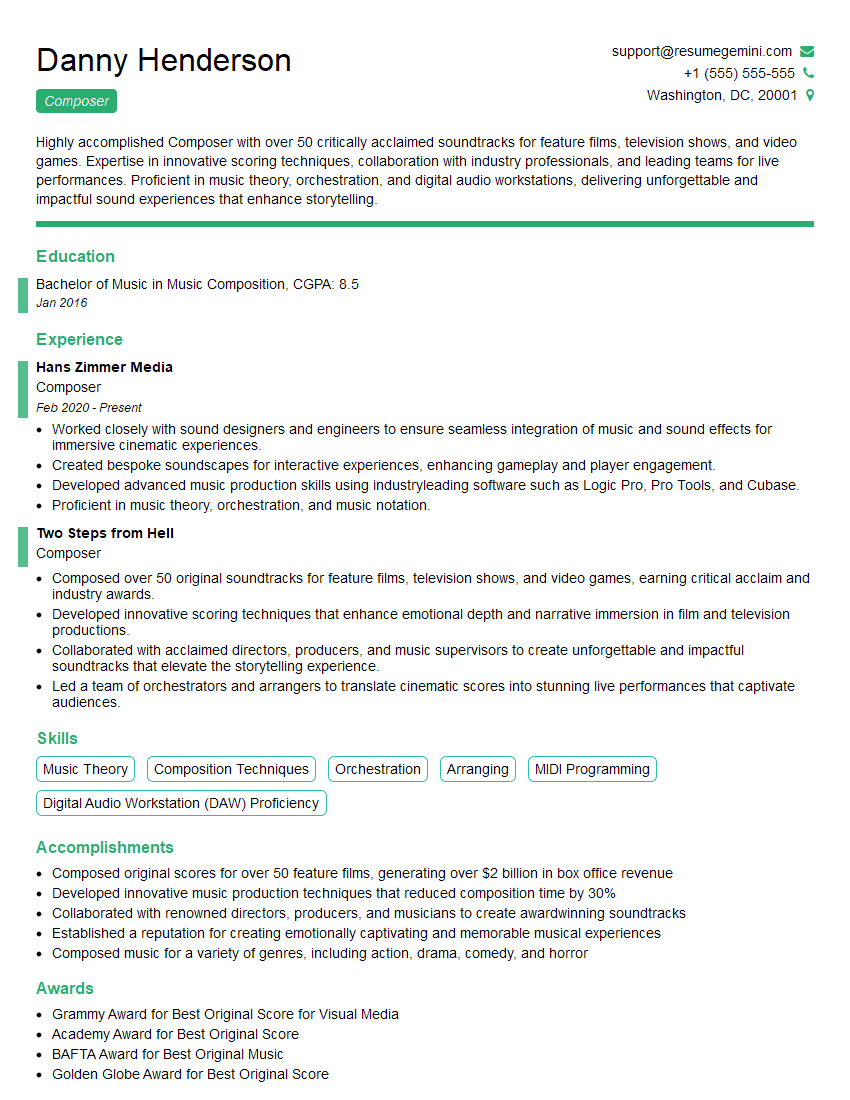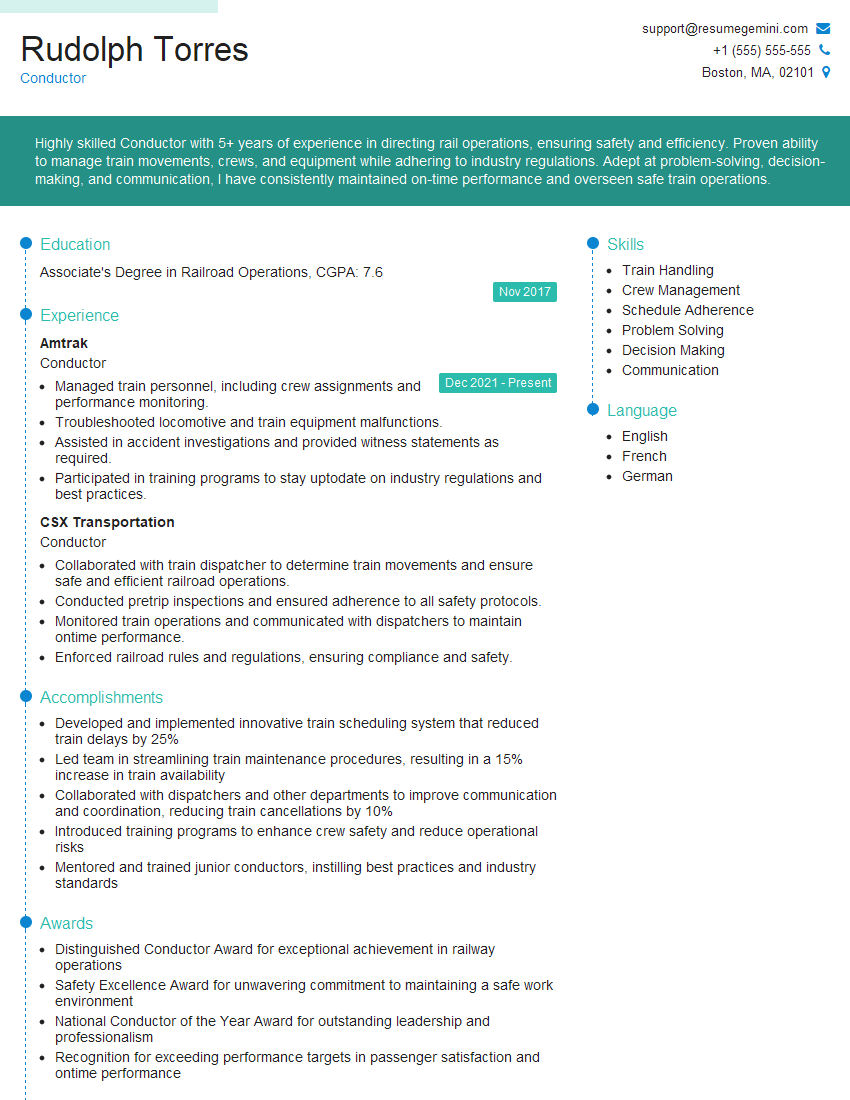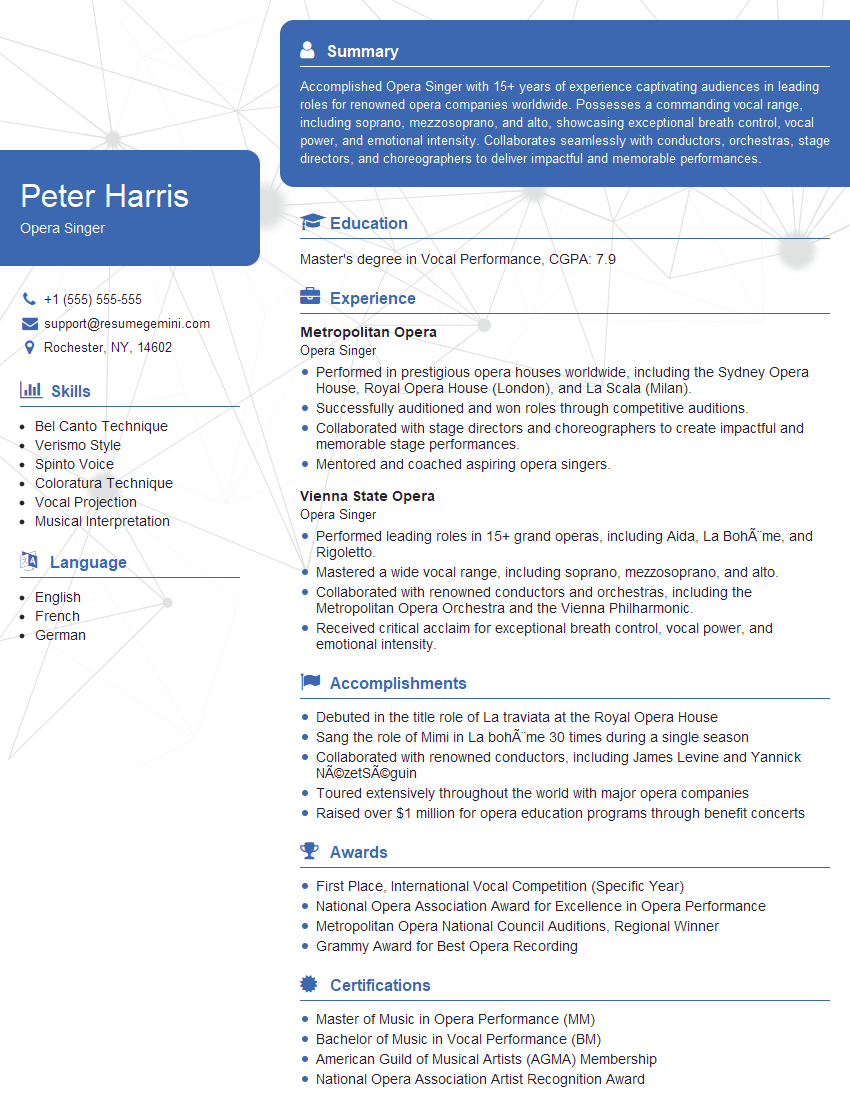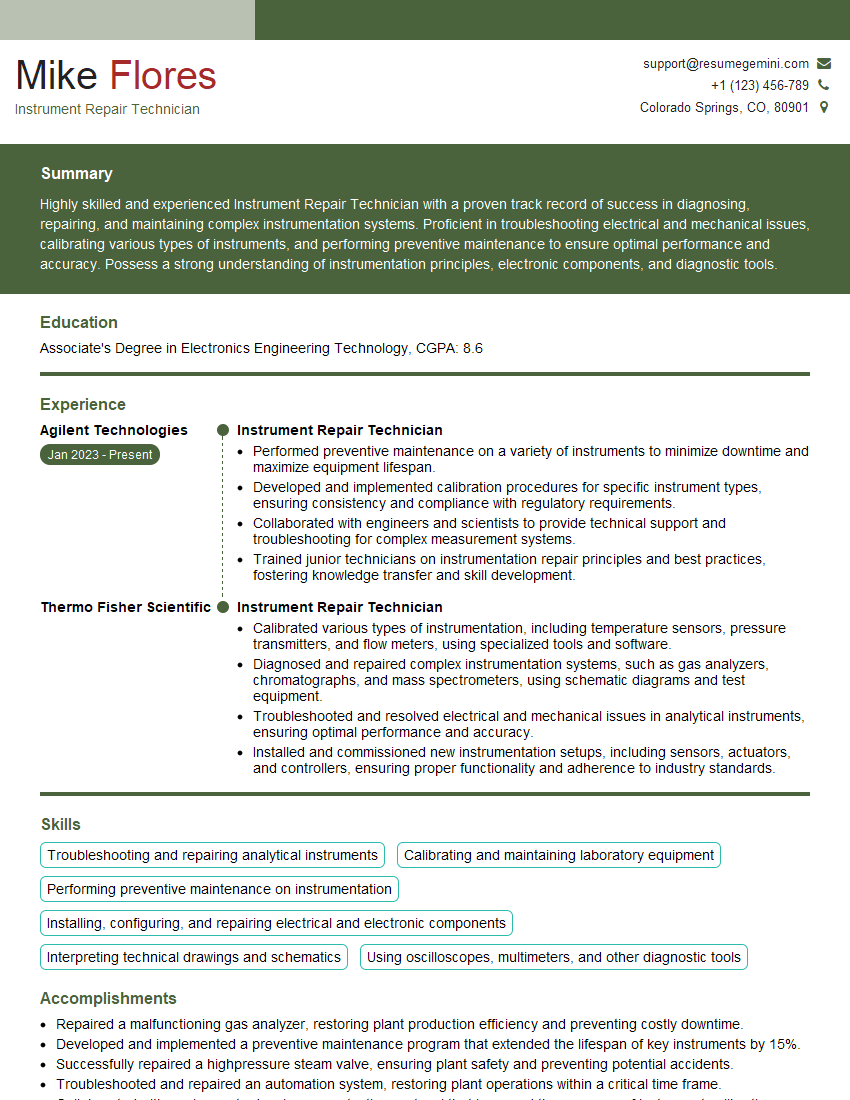Preparation is the key to success in any interview. In this post, we’ll explore crucial Classical Music interview questions and equip you with strategies to craft impactful answers. Whether you’re a beginner or a pro, these tips will elevate your preparation.
Questions Asked in Classical Music Interview
Q 1. Define ‘tonality’ and explain its evolution in Classical music.
Tonality refers to the system of organizing pitches around a central tone, the tonic, creating a sense of key and harmonic stability. Think of it as the musical equivalent of a home base in baseball – all the pitches relate back to that central tone. The evolution of tonality in Classical music is a fascinating journey.
Early Classical Period (roughly 1730-1770): Tonality was generally well-established, following Baroque conventions. Composers like Bach largely used a diatonic system (seven notes within an octave), focusing on functional harmony— chords moving in predictable ways to create a sense of resolution.
Classical Period (roughly 1770-1820): Mozart and Haydn refined the Classical style, exploring more complex harmonic progressions within a still relatively clear tonal center. There’s a greater sense of elegance and balance.
Late Classical/Early Romantic (roughly 1820 onwards): Composers like Beethoven began to push the boundaries of tonality. We see more modulation (shifting between keys) creating a sense of dramatic tension and release, blurring the lines between tonal centers to a greater degree than their predecessors. This paves the way for the increased chromaticism and eventual breakdown of traditional tonality in the Romantic period.
Essentially, the evolution of tonality in Classical music reflects a growing exploration of harmonic possibilities, starting from established conventions and culminating in more expressive and complex harmonic language.
Q 2. Compare and contrast the compositional styles of Bach and Mozart.
Bach and Mozart, while both giants of their respective eras, represent distinct compositional styles. Bach, a Baroque composer, focused on counterpoint—the independent yet interwoven melodic lines. Imagine a tapestry where each thread is a melody, all contributing to the overall richness of the fabric. Mozart, on the other hand, epitomized the Classical style, emphasizing clarity, balance, and elegant melodic lines, with a focus on homophony – where a single melody is supported by chords.
Bach: His music is often characterized by intricate counterpoint, elaborate ornamentation, and a more complex harmonic structure, though still within a functional framework. Think of the intricate fugues in The Well-Tempered Clavier.
Mozart: His compositions are known for their graceful melodies, balanced phrases, and clear formal structures. His operas, like The Marriage of Figaro, are masterpieces of elegant storytelling combined with memorable musical themes.
While vastly different in style, both composers possessed unparalleled mastery of their craft, leaving behind a profound legacy that continues to influence composers to this day. The difference might be likened to comparing a finely detailed, intricately woven tapestry to a beautifully sculpted marble statue: both are works of art, yet their approaches and effects are dramatically different.
Q 3. Explain the significance of the sonata form.
The sonata form is a fundamental structure in Classical music, particularly prominent in sonatas, symphonies, and string quartets. It provides a framework for developing musical ideas through a process of exposition, development, and recapitulation.
Exposition: Introduces the main themes (usually two), presented in the tonic (home) key and then a related key. Think of it as the setup of a story, introducing the characters and setting the scene.
Development: This section fragments, transforms, and explores the themes introduced in the exposition, often modulating to distant keys, creating tension and drama. It’s the rising action and conflict of the narrative.
Recapitulation: The main themes return, usually in the tonic key, bringing resolution and a sense of closure. This is the resolution of the story, tying everything together.
The sonata form is significant because it allowed composers to create large-scale works with dramatic arc, building tension and releasing it in a satisfying manner. It’s a blueprint for musical storytelling and remains a powerful structure even today.
Q 4. Describe the role of the conductor in a symphony orchestra.
The conductor is the central figure in a symphony orchestra, responsible for shaping the musical performance. Their role goes beyond simply beating time; it’s about artistic interpretation and communication.
Interpreting the Score: The conductor studies the composer’s score, developing an interpretation that reflects their understanding of the music’s style, historical context, and emotional content.
Shaping Dynamics and Tempo: They control the orchestra’s dynamics (loudness and softness) and tempo (speed), ensuring a cohesive and expressive performance. They might subtly adjust these aspects to heighten emotional impact.
Communicating with Musicians: The conductor acts as a bridge between the composer’s intentions and the musicians’ execution. They guide the musicians through complex passages and ensure stylistic unity.
Rehearsals: Conductors lead rehearsals, guiding the orchestra to achieve their artistic vision. This collaborative process is crucial to producing a unified and polished performance.
Think of the conductor as the architect, visualising and directing the construction of the performance. It’s a delicate balance of leadership, musical insight, and effective communication.
Q 5. Identify three major periods in Classical music history and their defining characteristics.
Classical music history is typically divided into several periods. Here are three major ones:
Baroque (roughly 1600-1750): Characterized by elaborate ornamentation, complex counterpoint, and a focus on grandeur and drama. Composers like Bach and Handel dominated this era. Think of the elaborate organ works of Bach or the dramatic operas of Handel.
Classical (roughly 1730-1820): Emphasized clarity, balance, and elegance. This period saw the rise of the symphony, sonata, and string quartet, with composers like Haydn, Mozart, and Beethoven defining the style. The shift is toward greater structural clarity and simplicity compared to the Baroque.
Romantic (roughly 1820-1900): This period prioritized emotional expression and individualism. Music became more expressive, with a focus on larger orchestras, dramatic dynamics, and intense emotions. Composers like Chopin, Liszt, Brahms, and Wagner represent this era.
These periods represent significant stylistic shifts in musical composition and reflect broader changes in society and philosophy.
Q 6. Discuss the differences between a string quartet and a symphony.
String quartets and symphonies are both important forms in Classical music, but they differ significantly in terms of instrumentation and scale:
String Quartet: A chamber music ensemble featuring two violins, a viola, and a cello. It’s intimate and emphasizes interplay between the four instruments. The focus is on detailed counterpoint and interplay, fostering a more intimate and subtle musical experience.
Symphony: A large-scale orchestral work typically comprising four movements, each with its own distinct character. The symphony utilizes a much larger ensemble—strings, woodwinds, brass, and percussion—allowing for a greater range of dynamics, textures, and timbral possibilities. It allows for broader emotional expression on a bigger scale, capable of creating powerful crescendos and dramatic shifts in mood.
Think of the string quartet as a close conversation among friends, while the symphony is a grand public oration. Both are powerful musical forms, but they serve distinct purposes and create different listening experiences.
Q 7. What are the key characteristics of Baroque music?
Baroque music (roughly 1600-1750) is characterized by a number of key features:
Elaborate Ornamentation: Baroque music frequently employs intricate melodic decorations, such as trills, mordents, and appoggiaturas, adding expressive detail and virtuosity.
Counterpoint: The independent yet interwoven melodic lines are a hallmark of Baroque style. Multiple independent melodies simultaneously enrich the texture of the music.
Terraced Dynamics: Instead of gradual changes in volume, Baroque music often uses abrupt shifts between loud and soft passages. This created a sense of drama and stark contrast.
Basso Continuo: A continuous bass line, often played by a harpsichord or organ along with a cello, provided a harmonic foundation for the melodic lines above. This provided a constant, strong harmonic undercurrent.
Use of Ornamentation: Trills, mordents, and other ornaments were frequently used to decorate melodies, adding expressive detail.
The overall effect of these features is a sense of grandeur, complexity, and emotional intensity. It’s a style that showcases a mastery of musical technique and provides a rich tapestry of sound.
Q 8. Explain the concept of counterpoint.
Counterpoint is a fundamental compositional technique in classical music where two or more independent melodic lines are interwoven to create a harmonious and interesting texture. Think of it like a conversation between different voices, each with its own distinct personality and melody, yet working together to create a unified whole. It’s not just about combining melodies; it’s about how those melodies interact—their rhythms, their intervals, and how they complement or contrast each other.
There are various types of counterpoint, ranging from simple two-part counterpoint, where two voices move independently but harmoniously, to complex multi-part counterpoint found in fugues and canons. In simple counterpoint, one voice (often the cantus firmus or ‘fixed melody’) might maintain a steady rhythm, while the other voice moves more freely around it, creating a pleasing melodic and harmonic interplay. More complex forms introduce techniques like imitation, where one voice echoes the melody of another, and inversion, where a melody is played upside down. The masterful use of counterpoint is evident in the works of composers like J.S. Bach, whose fugues are shining examples of the art.
Understanding counterpoint is crucial for analyzing and appreciating classical music, as it provides a framework for understanding the relationships between different musical lines and the overall structure of a composition.
Q 9. What are the different types of musical texture?
Musical texture describes the way different musical lines or layers are combined to create a sonic effect. It’s essentially the fabric of the music. We can categorize texture into several main types:
- Monophony: A single melodic line without harmony. Think of a Gregorian chant or a solo instrument playing a simple melody.
- Homophony: A melody supported by chords. This is the most common texture in Western music, exemplified by many popular songs and much of the classical repertoire. The melody is the main focus, and the chords provide harmonic support.
- Polyphony: Two or more independent melodic lines of equal importance occurring simultaneously. This is the realm of counterpoint, where each voice has its own distinct melodic character, as discussed earlier. Fugues are a prime example.
- Heterophony: Simultaneous variations of the same melody. This is more common in certain folk traditions, where several instruments or voices might play the same basic melody with slight variations.
- Atexture: The absence of discernible musical lines. Think of some minimalist or ambient compositions, where sound is more textural than melodic.
The texture of a piece can dramatically affect its mood and expression. A simple monophonic texture might evoke a sense of serenity, while a complex polyphonic texture can be intense and dramatic.
Q 10. Name three prominent female composers of Classical music.
While many talented female composers were historically underrepresented, three prominent figures who deserve recognition are:
- Clara Schumann (1819-1896): A virtuoso pianist and composer, she was a significant figure in the Romantic era, known for her expressive piano works and Lieder (art songs).
- Fanny Mendelssohn Hensel (1805-1847): Sister of Felix Mendelssohn, she was a gifted composer in her own right, but many of her works were not published during her lifetime due to societal constraints on women composers. Her chamber music and piano works are increasingly recognized for their beauty and sophistication.
- Lili Boulanger (1893-1918): One of the first women to win the prestigious Prix de Rome, she was a remarkably talented composer with a tragically short life. Her poignant and expressive works show a mastery of form and orchestration.
Many other women composers deserve recognition, and ongoing research continues to uncover and celebrate their contributions to classical music.
Q 11. Describe your experience with a specific piece of Classical music.
A piece that has deeply impacted me is Bach’s Chaconne from Partita No. 2 for solo violin in D minor. It’s a monumental work of profound emotional depth. The technical demands are staggering, requiring incredible virtuosity and stamina. But beyond the technical brilliance, it’s the emotional journey that captivates. The Chaconne’s structure, based on a repeating bass line (the chaconne), allows for an extraordinary exploration of human emotion; from grief and despair to hope and triumph. I’ve spent countless hours studying and performing sections of this piece, and each time I find new layers of meaning and complexity. The sheer architectural grandeur of the piece, combined with the intimate expression of the solo violin, makes it a truly unforgettable experience.
Analyzing the harmonic progressions, the subtle shifts in dynamics, and the masterful use of counterpoint within the solo line is both intellectually stimulating and emotionally moving. It’s a piece that continues to challenge and inspire me.
Q 12. Discuss the challenges of performing a solo piece versus playing in an ensemble.
Performing a solo piece versus playing in an ensemble presents very different challenges. A solo performance places the entire responsibility for the musical interpretation on the performer. The pressure is immense, as there’s no one to share the burden of maintaining tempo, dynamics, and articulation. The performer needs meticulous preparation, impeccable technical skills, and the ability to command attention and communicate the music’s essence to the audience with complete conviction.
Playing in an ensemble, on the other hand, necessitates collaboration, listening skills, and the ability to adjust to the nuances of other performers. While the individual responsibility is lessened, the challenge shifts to maintaining a unified sound, blending with others while also contributing individually to the overall performance. The success of an ensemble depends on each member’s ability to listen actively, compromise, and support the others while projecting one’s own musical voice effectively. Both require discipline and dedication, but in completely different ways.
Q 13. How would you handle a disagreement with a fellow musician during a rehearsal?
Disagreements in a rehearsal are inevitable. My approach is always to address the issue professionally and respectfully. I’d begin by listening carefully to the other musician’s perspective, trying to understand their reasoning. Then, I’d clearly and calmly articulate my own point of view, focusing on the musical aspects rather than resorting to personal attacks.
If we’re debating interpretive choices, I’d suggest referencing the score, the composer’s intentions (if known), and exploring alternative interpretations. If the disagreement pertains to technical aspects, we might try different approaches, experimenting to find a solution that benefits both the ensemble and the individual’s capabilities. The goal is always to find a common ground that enhances the overall performance. If necessary, I’d involve the conductor or a more experienced musician to mediate.
Ultimately, the priority is the success of the musical performance, so maintaining a respectful dialogue and seeking solutions collaboratively is essential.
Q 14. Explain the importance of musical phrasing.
Musical phrasing is the shaping of musical lines into meaningful units. It’s analogous to punctuation and sentence structure in written language. Instead of periods and commas, we use pauses, crescendos, diminuendos, and changes in tempo to create musical ‘phrases’ that convey meaning and emotion.
Effective phrasing is crucial for communicating the composer’s intentions and making the music expressive. A well-phrased musical line flows naturally, conveying emotion and narrative. Imagine a singer who simply sings a melody note-by-note without any expressive phrasing – it would sound robotic and devoid of emotion. In contrast, a skilled singer would use phrasing to emphasize key words, create tension and release, and guide the listener through a narrative arc.
By carefully considering dynamics, tempo fluctuations, and articulation within a phrase, a musician can transform a simple melody into a compelling and meaningful statement, breathing life into the composer’s intentions. Neglecting phrasing results in a flat and lifeless performance, irrespective of technical skill.
Q 15. Discuss the role of dynamics in musical expression.
Dynamics in music are like the volume control of a story. They dictate the intensity and emotional weight of the music, shaping the listener’s experience. Think of a crescendo, a gradual increase in volume, building tension like a rising storm. Conversely, a diminuendo, a gradual decrease in volume, can evoke a sense of calm or release, like the gentle fading of sunset. Dynamics aren’t just about loud and soft; they’re about nuance. A composer might use pianissimo (pp, very soft) to create intimacy, while fortissimo (ff, very loud) might convey power or excitement. The skillful use of dynamics is crucial for shaping phrases, highlighting melodic lines, and creating dramatic impact. For example, in Beethoven’s Fifth Symphony, the iconic opening motif is played forte, immediately establishing a sense of struggle and urgency, which is then contrasted later with softer passages, increasing the emotional impact.
Consider also the use of sforzando (sf), a sudden, forceful accent, or crescendo a poco a poco (gradually increasing volume), which adds layers of expressive detail. Mastering dynamics is essential for any performer seeking to communicate the composer’s intent and convey a compelling musical narrative.
Career Expert Tips:
- Ace those interviews! Prepare effectively by reviewing the Top 50 Most Common Interview Questions on ResumeGemini.
- Navigate your job search with confidence! Explore a wide range of Career Tips on ResumeGemini. Learn about common challenges and recommendations to overcome them.
- Craft the perfect resume! Master the Art of Resume Writing with ResumeGemini’s guide. Showcase your unique qualifications and achievements effectively.
- Don’t miss out on holiday savings! Build your dream resume with ResumeGemini’s ATS optimized templates.
Q 16. Describe your understanding of musical form.
Musical form refers to the overall structure and organization of a musical piece. It’s the blueprint that guides the listener through the composer’s journey. Think of it as the architecture of a musical composition. There are many forms, each with its own conventions. The simplest is binary form (AB), where a piece is divided into two distinct sections – A and B – often with a return to A at the end. A ternary form (ABA) adds a return to the initial section. Sonata form, a cornerstone of the Classical period, is much more complex, typically involving an exposition (presenting the main themes), a development (exploring and transforming those themes), and a recapitulation (restatement of the themes). Other forms include rondo (ABACA), theme and variations, and fugue. Understanding musical form allows you to anticipate what will happen next in a piece, enhancing your appreciation of the composer’s design and artistry. Recognizing these forms aids both performance and analysis, allowing a deeper engagement with the musical work.
Q 17. What are your preferred methods for learning and memorizing new musical scores?
Learning and memorizing new scores is a process that combines analytical and kinesthetic approaches. Firstly, I begin by carefully reading the score, analyzing the structure, harmonic progressions, and melodic lines. I identify key phrases and sections, paying close attention to formal structures like sonata form or variations. I then break the piece into smaller, manageable sections. I might record myself playing these sections slowly and repeatedly, focusing on accuracy and phrasing before gradually increasing tempo. This approach integrates active listening and physical practice. Using a piano or other instrument during this process is crucial; the physical act of playing strengthens memorization significantly. Furthermore, I find it beneficial to record myself playing and subsequently listen back, enabling me to identify areas that need further attention and refine my interpretation. Mental rehearsal, visualizing myself playing the piece, is also a powerful technique, particularly for sections that prove challenging. This multi-faceted approach significantly improves memorization and performance.
Q 18. Explain the difference between major and minor keys.
Major and minor keys are two fundamental building blocks of Western music, defining the overall mood and character of a piece. The difference lies primarily in their characteristic scales. A major scale is built with intervals of whole and half steps in the pattern W-W-H-W-W-W-H (where W = whole step, H = half step). This arrangement creates a bright, cheerful sound. A minor scale has a pattern of W-H-W-W-H-W-W; this produces a more somber, reflective mood. For example, C major is bright and uplifting, while C minor feels darker and more pensive. The third degree of the scale is particularly important in differentiating the two. In a major key, the third is a major third (four semitones above the tonic), while in a minor key, it is a minor third (three semitones above the tonic). This difference alone significantly contributes to the contrasting emotional qualities of these two key types. This applies to nearly all aspects of music, from melody and harmony to overall emotional impact. The contrast between major and minor is a fundamental tool composers use to express a wide range of human emotions.
Q 19. What are the different types of musical notation?
Musical notation is the system used to write down music. Several types exist, each with its own strengths and limitations. The most common is staff notation, using a five-line staff with notes placed on the lines and spaces. It shows pitch, rhythm, and dynamics. Tablature, often used for fretted instruments like guitar or lute, indicates finger placement rather than pitch. Numeral notation, simpler than staff notation, uses numbers to represent chords or melodic intervals. Graphic notation, a more modern approach, uses visual symbols rather than traditional noteheads, often employed for experimental or contemporary compositions. For example, a composer might use visual symbols to represent specific timbral qualities or performance instructions. Each type of notation serves a specific purpose, and understanding their differences is crucial for interpreting and performing music effectively.
Q 20. Describe your experience with music technology and software.
My experience with music technology and software spans various applications. I’m proficient in using Digital Audio Workstations (DAWs) like Logic Pro X and Ableton Live for recording, editing, and mixing audio. I utilize notation software such as Sibelius and Finale for creating and editing scores, often integrating them with DAWs for a seamless workflow. I also have experience with virtual instruments and effects plugins, allowing for creative manipulation of sound. Furthermore, I’m familiar with music library management software and online resources for accessing scores and researching musical history. This technology enhances my creative process, facilitates collaboration, and broadens my access to musical resources, allowing for meticulous editing and experimentation with different sounds and techniques.
Q 21. How do you approach sight-reading?
Sight-reading, the ability to read and perform music at first sight, is a fundamental skill for any musician. My approach involves several key steps. Firstly, I scan the piece to get an overall sense of its structure, key, and time signature. Then, I focus on the main melodic line, paying close attention to rhythm and intervals. I don’t strive for perfection on the first attempt, aiming for a general understanding of the piece’s flow. I proceed section by section, focusing on melodic contour and rhythmic patterns before incorporating harmony and accompaniment. Practice is essential; regular sight-reading exercises, such as playing short excerpts from unfamiliar pieces, considerably improve this skill. A focus on understanding the underlying harmonic structure and the relationships between the melodic and harmonic materials enhances accuracy and fluidity. The ability to quickly identify key signatures, time signatures and rhythmic patterns allows a smoother and more confident reading experience.
Q 22. What are your strengths and weaknesses as a musician?
My greatest strength lies in my deep understanding and nuanced interpretation of Classical music. Years of dedicated study have allowed me to develop a highly refined technique on the piano (my primary instrument), coupled with a keen analytical ear that allows me to dissect complex scores and bring out their emotional depth. I excel at collaborative work, easily adapting my playing to suit the strengths of fellow musicians.
However, like all musicians, I have areas for improvement. While I am proficient in many periods of Classical music, my expertise in early music (pre-Baroque) is still developing. I am actively working to expand my repertoire in this area through further study and performance opportunities. Additionally, while I enjoy performing solo, I recognize the need to improve my self-promotion and networking skills to build a wider audience for my work.
Q 23. Explain your understanding of copyright law in relation to music.
Copyright law in music is complex, but fundamentally protects the composer’s intellectual property rights. This means that only the copyright holder (or someone granted permission) can reproduce, distribute, perform, display, or create derivative works based on a musical composition. For instance, a pianist cannot publicly perform a copyrighted piece without obtaining a license from the copyright holder (which could be the composer’s estate, a publisher, or a collective management organization like ASCAP or BMI).
Copyright protection typically lasts for a set period, often extending for decades after the composer’s death. However, there are nuances. For example, works published before a certain date may be in the public domain, meaning they are free to use. The rules can also vary by country. Understanding these rules is crucial for any musician, to avoid infringement and ensure ethical and legal practice.
Practical implications include obtaining licenses for performance rights, acknowledging composers properly in program notes, and being mindful of using online resources containing copyrighted music responsibly. Failure to comply can result in legal action and significant penalties.
Q 24. How do you adapt your performance style to different venues and audiences?
Adapting my performance style depends entirely on the venue and audience. In a large concert hall, I would adopt a broader, more resonant tone, mindful of projecting to the back of the room. My dynamic range would likely be greater, using pianissimo and fortissimo more dramatically. In a smaller, more intimate setting, like a recital hall or a chamber music performance, the sound needs to be more delicate and nuanced, allowing the audience to experience the subtleties of phrasing and articulation.
Audience considerations are equally vital. A young, unfamiliar audience might benefit from program notes or introductory remarks that provide context, whereas a seasoned audience might appreciate a more interpretive, spontaneous approach. I find careful observation of the audience’s response helps to gauge the appropriate emotional energy and level of engagement required during the performance. For instance, I might incorporate more audience interaction (brief spoken asides about a piece’s history) in a relaxed setting compared to a formal concert.
Q 25. Describe your approach to teaching Classical music.
My teaching philosophy centers on fostering a deep love for music alongside a strong technical foundation. I believe that learning classical music should be a journey of discovery, not just rote memorization. I begin by assessing each student’s individual strengths and weaknesses, tailoring my approach to meet their specific needs.
My lessons incorporate a balance of technical exercises (scales, arpeggios, etudes), musical theory, history, and performance practice. We work on pieces from a variety of eras and styles, always aiming for a nuanced understanding of the composer’s intent and emotional content. I emphasize musicianship above all, encouraging students to listen critically, analyze, and express their own interpretation. I believe in creating a supportive and encouraging environment where students feel confident to explore their musicality freely.
For example, rather than simply teaching finger exercises, I relate them to the challenges of playing specific musical passages. Instead of only learning the notes, we discuss the historical context and the emotional narrative of the piece. This holistic approach helps cultivate a deeper appreciation and understanding of the music.
Q 26. Explain the historical context of a specific musical movement.
Let’s examine the Viennese Classical period (roughly 1730-1820). This era, dominated by Haydn, Mozart, and Beethoven, marked a pivotal shift in musical style. It moved away from the ornate and elaborate Baroque period, towards a more balanced and structured aesthetic, characterized by clarity, elegance, and formal precision.
The historical context is multi-faceted. The Enlightenment, with its emphasis on reason and order, significantly influenced the music of this time. The rise of the public concert hall and the growing middle class created a demand for accessible and entertaining music. Patronage systems, while still prevalent, started to give way to a more independent position for composers.
This period saw the standardization of the symphony, string quartet, and sonata forms, establishing structures that would influence composers for centuries. There was also a growing emphasis on thematic development and the use of motifs, creating a sense of unity and coherence within compositions. The development of musical notation and the increasing standardization of instruments also contributed to the evolution of the Viennese Classical style. It was truly a period of innovation and refinement, laying the groundwork for the Romantic era that followed.
Q 27. Discuss your experience working collaboratively within a musical ensemble.
Collaboration in a musical ensemble is essential for a successful performance. My experience working in various chamber groups has taught me the value of mutual respect, active listening, and clear communication. It’s not simply about playing your part correctly; it’s about blending seamlessly with others, understanding the nuances of individual playing styles, and supporting the overall artistic vision.
I’ve found that successful collaboration involves open discussions about interpretation, dynamics, and phrasing. It also requires flexibility and a willingness to compromise. In one particular string quartet performance, we spent hours refining a transition between movements, carefully adjusting our bowing and intonation to achieve the perfect seamless flow. The end result was a much richer and more expressive performance than any of us could have accomplished individually. The process of collaborative problem-solving often strengthens the overall artistic output and creates an even more rewarding experience for all involved.
Q 28. What are your career aspirations in the field of Classical music?
My career aspirations involve a multifaceted approach to Classical music. I aim to continue performing solo and chamber music at a high professional level, expanding my repertoire and reaching wider audiences. I also aspire to teach at a university level, sharing my passion for classical music with the next generation of musicians. I envision combining my performance and teaching experience by establishing masterclasses and workshops that bridge the gap between academic study and practical application.
Further, I am interested in exploring opportunities in music scholarship and historical research, contributing to a deeper understanding and appreciation of Classical music. My ultimate goal is to make a significant contribution to the world of Classical music, both as a performer and educator, inspiring others to engage with this rich and enduring art form.
Key Topics to Learn for Your Classical Music Interview
- Historical Periods & Styles: Develop a deep understanding of Baroque, Classical, Romantic, and 20th-century styles; analyze their compositional techniques and musical characteristics.
- Form and Structure: Master the analysis of sonata form, rondo form, fugue, and other common forms; apply this knowledge to analyze and discuss specific works.
- Harmony and Counterpoint: Demonstrate a strong grasp of harmonic progressions, voice leading, and contrapuntal techniques; be prepared to discuss specific examples from the repertoire.
- Instrumentation and Orchestration: Understand the capabilities and limitations of various instruments and how they are used in orchestral and chamber music settings; be able to discuss scoring choices.
- Musical Analysis: Practice analyzing musical scores, identifying thematic material, harmonic structures, and formal outlines; be ready to articulate your analytical approach clearly and concisely.
- Performance Practice: Familiarize yourself with historical performance practices and their impact on interpretation; be able to discuss different approaches to a given piece.
- Composers and their Works: Develop a strong knowledge of major composers and their most significant works; be able to discuss their stylistic innovations and contributions to musical history.
- Improvisation (if applicable): If relevant to the position, prepare examples showcasing your improvisation skills within the classical context.
Next Steps
Mastering Classical Music theory and history opens doors to a fulfilling career in performance, teaching, research, or administration. A strong understanding of these fundamentals will significantly improve your interview performance and showcase your expertise. To maximize your job prospects, crafting a professional, ATS-friendly resume is crucial. ResumeGemini is a trusted resource that can help you build a compelling resume tailored to the Classical Music industry. Examples of resumes specifically designed for Classical Music professionals are available within the ResumeGemini platform to guide you. Take advantage of these tools to present your skills and experience effectively and land your dream role.
Explore more articles
Users Rating of Our Blogs
Share Your Experience
We value your feedback! Please rate our content and share your thoughts (optional).
What Readers Say About Our Blog
Hello,
We found issues with your domain’s email setup that may be sending your messages to spam or blocking them completely. InboxShield Mini shows you how to fix it in minutes — no tech skills required.
Scan your domain now for details: https://inboxshield-mini.com/
— Adam @ InboxShield Mini
Reply STOP to unsubscribe
Hi, are you owner of interviewgemini.com? What if I told you I could help you find extra time in your schedule, reconnect with leads you didn’t even realize you missed, and bring in more “I want to work with you” conversations, without increasing your ad spend or hiring a full-time employee?
All with a flexible, budget-friendly service that could easily pay for itself. Sounds good?
Would it be nice to jump on a quick 10-minute call so I can show you exactly how we make this work?
Best,
Hapei
Marketing Director
Hey, I know you’re the owner of interviewgemini.com. I’ll be quick.
Fundraising for your business is tough and time-consuming. We make it easier by guaranteeing two private investor meetings each month, for six months. No demos, no pitch events – just direct introductions to active investors matched to your startup.
If youR17;re raising, this could help you build real momentum. Want me to send more info?
Hi, I represent an SEO company that specialises in getting you AI citations and higher rankings on Google. I’d like to offer you a 100% free SEO audit for your website. Would you be interested?
Hi, I represent an SEO company that specialises in getting you AI citations and higher rankings on Google. I’d like to offer you a 100% free SEO audit for your website. Would you be interested?
good
